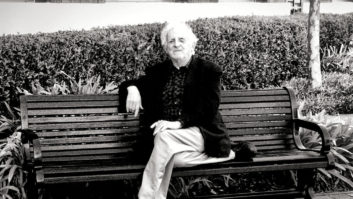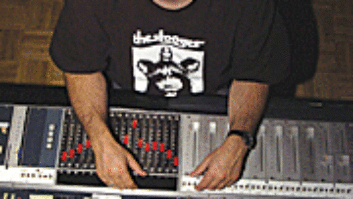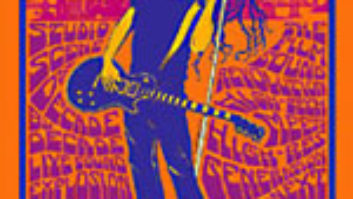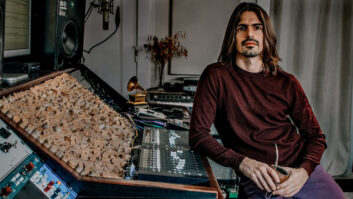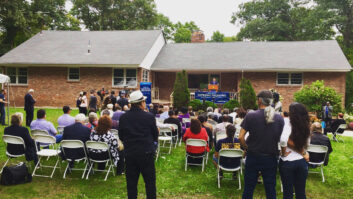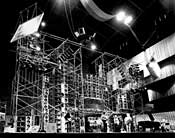

The Grateful Dead’s infamous Wall of Sound
Photo: Hal Randall
Jefferson Airplane lead singer Grace Slick is credited with the quote: “Anyone who says they remember San Francisco in the ’60s wasn’t really there.” That’s also true of a large portion of the ’70s. The ’80s and ’90s, of course, have their own legends and hyperbole. However, there’s no debating the fact that the Bay Area was a gestation hotbed for new ideas in music and concert sound. From the wild inventions of the Grateful Dead and Bill Graham’s rollicking Days on the Green, to the innovation of Ultra Sound, Meyer Sound Labs and more, the Bay Area sound community has long showed uncommon imagination and skill. The following is a microversion of the long strange trip that is San Francisco’s sonic memory lane.
Sound on Stage has been providing sound reinforcement since 1972 (its current clientele includes Jackson Browne, Neil Young, Journey and private gigs for artists such as Sheryl Crow and Sting), but long before that, owner Jerry Pfeffer was part of the local music scene, playing in bands and attending concerts. “There wasn’t much in the way of sound systems back then,” he says with a laugh. “You might have four or five Voice of the Theater and JBL 4560 boxes and some horns — that was it. No monitors to speak of; at first, no monitors at all.”
A bass player working in a hi-fi store, Pfeffer began assembling sound systems for shows. The criteria for landing a gig doing sound was simple: Did you have enough gear? “When somebody called up, they’d ask, ‘How many of this? How many of that? How much power you got?’ I started out using hi-fi speakers and amps off the showroom floor and taking them to gigs. Then for years, I built my own speakers out of JBL components. You could buy all sorts of raw components, but you couldn’t just buy a system.”
At the time, S.F.’s biggest sound vendor was Harry McCune Sound Services. Founded in 1932 by Harry McCune Sr. and now called McCune Sound, Lighting & Video, McCune is still an independent family business run by McCune’s grandson, Allan McCune. It was McCune Sound Services that provided sound reinforcement for the 1967 seminal Monterey Pop Festival and, even before that, The Beatles’ last-ever live performance, held at S.F.’s Candlestick Park. According to Allan McCune, the McCune log book entry for that historic 1965 show reads: “Bring everything you can find!”
When Harry McCune Sr. began renting sound systems to big bands in the ’30s and ’40s, the company developed a wide client base, servicing everything from school productions to corporate events, theatrical musicals and rock concerts. McCune was one of the very first companies to provide touring sound systems, beginning in 1965 with Herb Alpert & The Tijuana Brass and progressing to such diversity as Andy Williams, Creedence Clearwater Revival and Beatlemania.
“With the rock bands, the demands on sound equipment grew more quickly than the available systems,” explains Allan McCune. “People were modifying Altec A7 Voice of the Theater speakers or Shure Vocalmasters and playing with all sorts of different horn combinations. When shows got big, people stacked 20 or 30 cabinets. My father [Harry McCune Jr.] wanted reliability, so he started looking for someone to build a better [speaker] box. He went around to all the manufacturers, but nobody would listen. We just weren’t buying enough to convince manufacturers to build what we needed.”
Meanwhile, other Bay Area sound people were struggling with the same issues. A major player at the time, also still in business today, was Oakland-based Swanson Sound, founded in 1926 by Art Swanson and purchased in 1952 by Donald A. Nielson. Swanson was one of the first companies to use bi-amplification, with active electronic crossovers feeding separate amplifiers for woofers and tweeters, an innovative concept for the time. Lumiere Productions, owned by Bob Cohen, was another original player. Tired of the show grind, Cohen ended up developing, with Charles Butten, ClearCom communications systems: the original gold standard for headset communication.

An early Meyer rig—quadraphonic!—at Pepperland in San Rafael
“I remember the first time Bob Cohen told me he had someone onstage just to run monitors,” says Pfeffer. “I couldn’t believe it — a guy just for that?! Bob wanted out of the biz, and he kind of handed his business off to me. Elvin Bishop and Tower of Power were my first big accounts. Elvin hit it big with ‘Fooled Around and Fell in Love.’ Then there were all kinds of bands: Journey, Pablo Cruise, Huey Lewis and The News, Starship, The Tubes.”
CHANGES IN THE WIND
In 1967, Berkeley-ite John Meyer was also working in a hi-fi store doing custom installs when Steve Miller dropped in looking to outfit his band for the Monterey Pop Festival. The Monterey Pop Festival and the subsequent film about it helped spread the rock gospel to the world, showcasing The Who, Jimi Hendrix, The Mamas & The Papas, The Byrds and the elite of San Francisco — based bands including Jefferson Airplane, Big Brother & The Holding Company featuring Janis Joplin, Quicksilver Messenger Service and the Grateful Dead. Meyer pitched in, providing Miller’s bass player with a custom hi-fi setup. Soon after, inspired by the music and its sonic challenges, he formed a company, dubbed Glyph, to build sound systems to service the exploding scene. Glyph’s first installation (in quadraphonic sound!) was at a San Rafael club called Pepperland and included three giant horns, each measuring 8×8 feet with 30-inch drivers. Pink Floyd, Janis Joplin and the Steve Miller Band played Pepperland, Frank Zappa visited and word got out. Soon, McCune Sound offered Meyer a job.
“At the time,” Meyer recalls, “all the equipment was either from the movie industry or hi-fi stores and it just wasn’t powerful enough. At shows, the equipment was literally burning up. You have to realize, 50 percent of the shows at that time never made it to the end! People were losing huge amounts of drivers per show. [Laughs] Everyone was in the re-coning business! So one of my main goals at McCune was to be able to make it to the end of the show.”
Another McCune priority was to design speakers that could travel. “When my father met with John,” relates Allan McCune, “he pulled out an Altec 604 [coaxial 15-inch driver] and said, ‘I want a speaker 10 times as loud as this with dimensions that will fit into a Boeing 727’s cargo area,’ because we were touring, doing Creedence, Hendrix and Peter Paul and Mary. John said, ‘I can do that,’ and [in 1972] came up with the JM3, the first real tri-amped box, an enclosed speaker cabinet with built-in crossovers and all the technology that’s evolved from that point forward.”
“It was basically a tri-amped, horn-loaded box,” Meyer elaborates, “with three amps built into a box in a rack that would drive two speakers. It had 4-pin connector cables that plugged in between the amp and the speaker. There were no controls. In the beginning, I didn’t even have an on/off switch: Plug it in the wall, it came on; unplug, it was off. Finally, after a lot of hassling, I relented and had them add two level controls. That was a huge concession on my part because I was trying to eliminate level controls. There were so many in the way everywhere, I figured we didn’t need more.”
When it became apparent that EQ was needed on a per-channel basis, McCune started building consoles, as well. “I wanted to get the EQ all in one place,” says Meyer, “so that the mixers would stop playing with the other components. When they did that, it changed the way the systems behaved. It also could damage parts. Again, we were trying to protect the equipment and make it through the show.”
“What John did, which was unheard of,” adds McCune, “was to make a complete designated system where the amp package was designed to match the speaker. Everything fit together; it didn’t have a variable crossover or amplifiers you could fuss with. Today, that sounds normal, but at the time, nobody thought it would work. Sound guys are notorious in that they want to touch everything. John’s idea was to allow the mixers to just mix without worrying about everything else.”
The new designs were innovative and successful; cost-effective, they were not. Building small runs of systems turned out to be prohibitively expensive. Says McCune, “It almost killed us. Fortunately, the rest of the sound world started wanting the same things. When John built his boxes, he forced everyone else to catch up. He applied science and technology in a way that forced the big manufacturers to pay attention. It shook them out of their comfort zone.”
THE BIG KAHUNA
When it came to concert production in the ’60s, ’70s — and ’80s — the biggest game in town was, of course, Bill Graham Presents. So it just made sense — at least for a while — for BGP to take charge of its own sound. Bob Barsotti started working for BGP in 1970, progressing through the box office and booking and becoming, ultimately, VP, a position he held until 2000 when the company was acquired by Clear Channel. “FM Productions was the company Bill started to provide the technical assistance he needed for his shows,” Barsotti explains. “Originally, bands didn’t have good setups of their own; the local promoter had to provide production to their specs. We weren’t happy with what we were able to rent, so we began developing sound and lighting to the specifications we were comfortable with.”
By the mid-’70s, BGP was promoting big outdoor stadium shows, for which available systems were completely inadequate. “We started spending money on new technology,” Barsotti continues. “We hired a sound wiz named Steve Gagne who developed things like long-throw bass horns: boxes that were giant Fiberglas horns, 10 or 12 feet in diameter. They were attached to giant bass speakers and we put them high up on scaffolds beside the stage. When you sat in the back row, it was incredible; it was the first time you could really feel the bass in a stadium.”
Most people have forgotten that in the early ’70s, speakers were hand-stacked. The art of stage rigging, with chain motors and scissor lifts, was nonexistent. “For example,” says Jim Downey, hired as a carpenter by FM in the early ’70s, “we had speakers called ‘salt bins’ where the box alone weighed about 300 pounds and it had an 8-foot Fiberglas extension horn attached to it. These things had to be stacked on platforms 30 feet or so in the air. We’d go 20 to 30 feet in the air, put sub platforms in and stack more cabinets on the platforms.
“At FM, we pioneered hanging baskets, where you could stack the sound system in a big basket, then lift it up with a chain motor. Systems today lock together and it all goes up on chain motors, but in the ’70s, there were individual cabinets for low, medium and high, all different sizes, and not made to be put together. We just stacked them on sound wings on the sides of the stage until Jay Drevers, who ran the carpentry shop, came up with the basket idea.
“Scissor lifts are taken for granted today; what we had was an early hydraulic experiment called Galloways. You’d put the sound on the platform, then you’d take it up and you could hang more sound underneath the platform. We only used it for a couple of tours, but it was innovative; no one had done it before. That was something great about FM. People thought outside the box.”
The last sound system designed by FM was a uniquely memorable vocal cluster built for Santana. “It was a sphere,” Downey describes, “with a half-section cut out that was then filled with 60 Meyer 12-inch speakers. It hung in the center of the stage, with the main low and midrange handled by speakers stacked off on the sides. It was very cool-looking and one of the first sound systems that needed three-phase power. It sucked a lot of juice!”
THE TRAIL OF THE DEAD
Up in Marin County, the Grateful Dead was following its own path; legendary Dead soundman Dan Healy was with them from almost the very beginning. Already a recording engineer when he first heard the band — circa 1965 at the pre-Bill Graham Fillmore — he soon found himself immersed in the sonic experiments that culminated in the fabled Wall of Sound.
“I knew what good sound was and what was coming off that stage was not good,” he says with a laugh. “Pigpen would be singing and there was just this gurgling stuff coming out of the speakers. The instruments totally drowned out the P.A.”
Healy soon discovered that he and Dead bandleader Jerry Garcia shared a similar vision for the band’s sound: to unite the music with the sound reinforcement electronics in a coherent way. At first, Healy and the others involved built systems out of commercially available equipment. But by the end of the ’60s, he notes, “We knew that much of the old design theory, done in the ’20s for talking pictures, no longer worked for us. Simply increasing the size of the package wasn’t physically practical. We needed the same size box, but 10 times louder and cleaner.”
The famed Wall of Sound was, in reality, an ever-changing conceptual vehicle, more a theory than actual pieces of equipment. “All of us involved — myself, Ron Wickersham, Owsley Stanley, John Curl and the others,” comments Healy, “had opinions and knowledge. The concept was that the sound designed the music and the music designed the sound, from the fingertips of the player to the ears of the audience.”
The apex of the Wall was reached sometime in 1974, when, according to Healy, “just looking at it was a spectacle.” It also took days to set up. For touring, one set of equipment and two sets of scaffolding leapfrogged the country, with installations tailor-made to the acoustic environment of each 2,000 to 6,000-seat venue.
One of the features was, according to Healy, the virtual elimination of intermodulation distortion; no two instruments went through any one speaker. And, perhaps most amazing, the Wall was musician-controlled: Each singer had a volume control on his microphone. Healy’s overall level control was limited to, he says laughing, “making suggestions. Of course, it turns out that you can’t stand onstage and play and have any idea what’s going on in the audience. Remember, nobody had done any of this before! There were a lot of things that didn’t work. To be honest, a lot of times it didn’t sound all that good!
“Ultimately,” he reflects, “the Wall of Sound either verified theories or debunked them. We learned a lot about rock-solid speaker cabinet design, which today is fundamental. The cabinets, which we built in our woodshop, became a standard of the industry for truly fine cabinets, built out of the 14-ply birch, which to this day, many manufacturers use. The Wall also vastly advanced speaker configuration: how to array speakers to gain maximum audio quality with minimum distortion.”
By 1974, the Dead and their crew were working 11-plus months a year, largely to support the Wall of Sound. “It was eating us alive,” says Healy. “Costs were skyrocketing, promoters were pissed at the extravagant setup time and we were so exhausted that we often had a difficult time remembering we were having fun.”
ULTRA-SOUND
As it turned out, for the grand experimenters, even the best rental systems didn’t suffice. For the Dead’s 1979 New Years Eve show at Oakland Auditorium, Healy and Starship soundman Don Pearson pooled their favorite components. The resulting five-way stereo system took days to assemble. Among other features, it had specially welded frames that held giant tweeter arrays. Horseshoe magnets served as air-motion [ribbon] transformers that were assembled in long vertical arrays and hung from scaffolding. Pearson says, “We built custom crossovers so we could align the individual components in time. It was, actually, the first-ever Time-Aligned™ live sound system.” [Eds. note: Time-Aligned™ is a trademark of E.M. Long and Associates.] It was also, according to Healy, such a great-sounding system that “we decided to get back into the business.”
“It was probably the best-sounding P.A. we ever did — to date!” adds Pearson. “It’s interesting to note that back then we were working on a technology design that just now is becoming very in vogue. We’re currently seeing the advent of ribbon speakers, something we were using in 1978!”
The system put together that night evolved into a company owned by Pearson and Howard Danchik that serviced both the Dead and Starship. In 1979, Meyer’s newly patented ACD studio monitors caught the ears of Starship and their monitor mixer, Owsley Stanley; the reaction was immediate. “Owsley went out and raised capital for us to build the first Ultra Monitors for Starship,” says Pearson. “They were John Meyer’s first official product. Then we built Starship a P.A. and then the Dead had to have one.”
Today’s widely used SIA Smaart software systems analyzer is another legacy born out of the Dead’s technological stew. “In the mid-’80s, Grateful Dead Productions purchased a Brüel and Kjaer 2032 dual-channel FFT analyzer,” explains Pearson, “which Healy and I used to develop a method for adjusting the interaction between a sound system and its environment. This technology, along with techniques developed by others, became the basis for Smaart.”
Pearson and Ultra Sound continued to provide sound reinforcement for the Dead until Garcia’s death in 1995. In 1999, Ultra Sound was sold to Pro Media, and its current clients include, among others, Dave Matthews Band, Primus, the Dead and Andrea Bocelli. Pearson stayed on as head engineer until this year; he currently works with Bocelli and consults on system installation/optimizition for such high-profile facilities as the American Airlines Center in Dallas, Shoreline Amphitheatre (Mountain View, Calif.) and Davies Symphony Hall (S.F.).
With the perspective of 30 years as a Bay Area sound person, Pearson looks back and says, “We were always coming up with new and better ideas to make the sound more thrilling for the audience. We saw the sound system as part of the whole experience, and we pushed the bar, even for today.”
Maureen Droney is Mix’s L.A. editor.

Click here to read more on BGP’s Days on the Green.
Alan McCune recalls the Beatles’ last show.Click here for text.
Click here to read live sound anecdotes from John Meyer, Bob Barsotti, Dan Healey and others.
